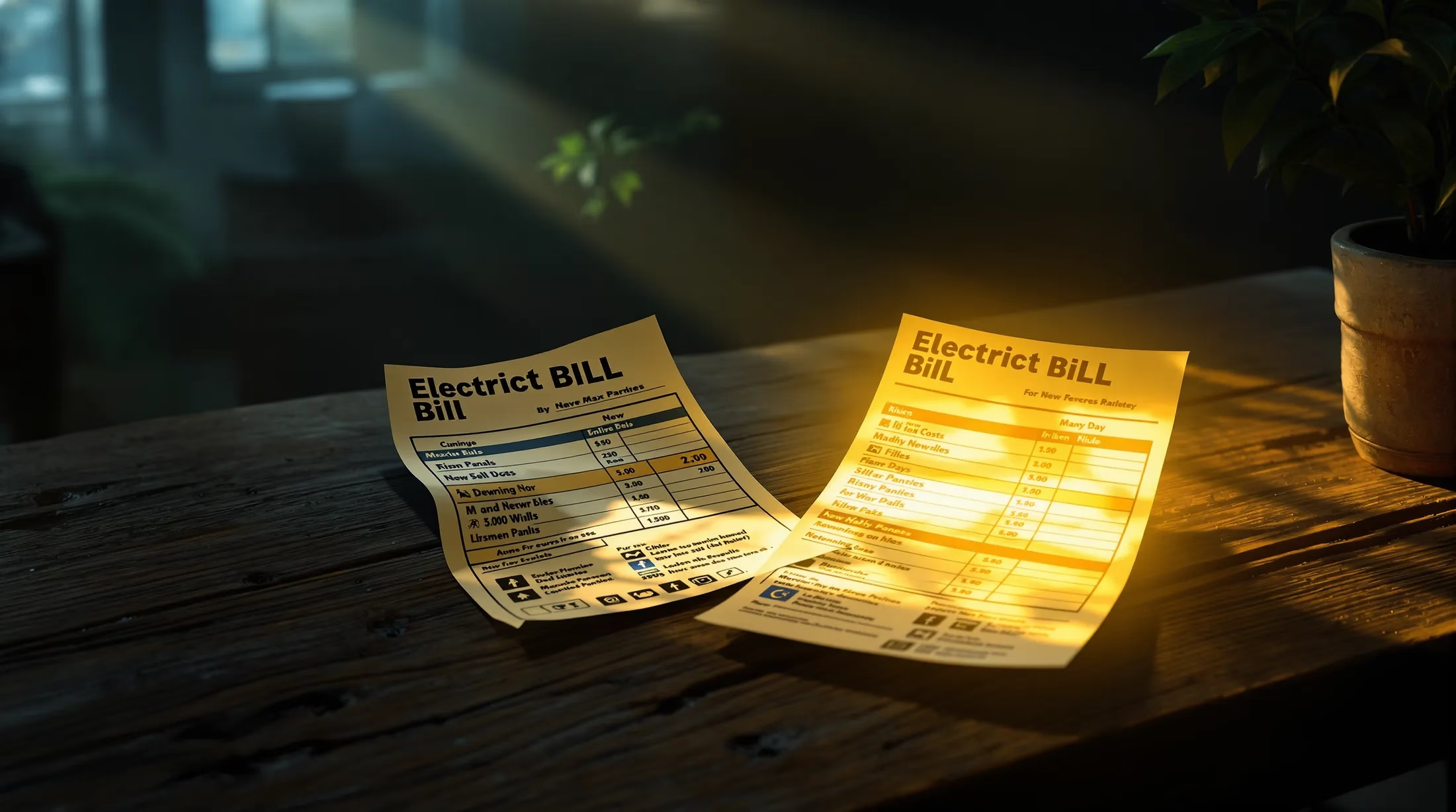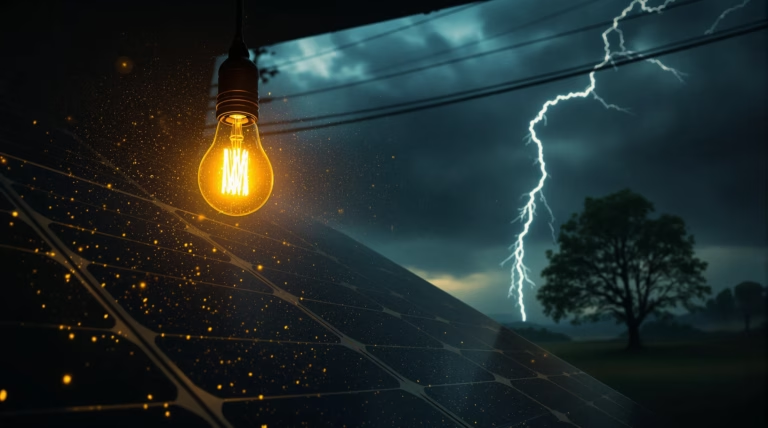Electric Bill Before and After Solar Panels: What to Expect
Making the switch to solar energy is a significant decision that can transform your household finances. Understanding how your electric bill works before and after solar panel installation is crucial for making an informed choice. Let’s explore what you need to know about this transition and its impact on your utility costs.
Understanding Your Electric Bill Before Solar Panels
Your electric bill is more than just a monthly expense – it’s a detailed record of your household’s electricity consumption patterns and associated costs. By analyzing this document, you can better evaluate the potential financial benefits of solar panel installation.
Most electric bills include your total consumption in kilowatt-hours (kWh), various rate structures, and utility grid connection fees. A 12-month analysis of your electricity usage provides crucial insights into peak consumption periods and their alignment with potential solar production, helping determine the optimal size for your solar panel system.
Components of a Typical Electric Bill
- Energy consumption charge – calculated by multiplying kWh used by the applicable rate
- Tiered rate plans – increasing costs as consumption rises beyond certain thresholds
- Time-of-use (TOU) charges – higher rates during peak demand periods
- Fixed charges – customer service fees, delivery costs, and infrastructure maintenance
- Additional fees – regulatory charges, environmental surcharges, and taxes
Factors Influencing Electricity Costs
| Factor | Impact |
|---|---|
| Regional Location | Urban vs. rural pricing differences, state-specific rates |
| Consumption Patterns | Daytime vs. evening usage, seasonal variations |
| Utility Policies | Time-of-use pricing, demand charges, annual rate increases |
| Weather Conditions | Heating/cooling requirements affecting monthly usage |
Impact of Solar Panels on Your Electric Bill
Solar panel installation transforms your home into an energy producer, typically reducing utility bills by 50-90%. This significant reduction begins immediately after installation and continues throughout the system’s 25+ year lifespan. However, you’ll likely still receive an electric bill due to grid connection and nighttime usage.
How Solar Panels Reduce Electricity Costs
- Direct offset – panels generate electricity for immediate home use, reducing grid dependency
- Energy independence – protection against utility rate increases
- Cost predictability – locked-in electricity costs for decades
- Usage optimization – monitoring capabilities help adjust consumption patterns
- Peak production benefits – ability to schedule high-energy activities during optimal solar hours
Understanding Net Metering and Its Benefits
Net metering stands as a powerful financial advantage for solar panel owners, allowing you to export surplus electricity back to the utility grid in exchange for bill credits. When your panels generate more power than needed during sunny periods, this excess energy flows to the grid, effectively reversing your electric meter. These accumulated credits can then offset your consumption during non-productive hours, such as nighttime.
| Net Metering Type | Benefit Structure |
|---|---|
| Full Retail Net Metering | Credit at same rate as consumption cost |
| Reduced Rate Programs | Lower credit value for excess production |
| Time-of-Use Adjustments | Variable credit rates based on time of day |
Potential Costs After Solar Installation
- Fixed monthly fees – $10-30 for grid maintenance and meter reading
- Nighttime grid usage – costs for electricity when panels aren’t producing
- Minimum bills – utility-specific mandatory charges
- Seasonal variations – higher winter costs due to reduced sunlight
- Connection fees – non-bypassable charges for grid access
Financial Considerations for Solar Panel Installation
The initial investment for solar panels typically ranges from $15,000 to $25,000 for an average-sized home, varying by system size, equipment quality, and location. This upfront cost represents a long-term investment that can eliminate or significantly reduce monthly electric bills over the system’s 25-30 year lifespan. Most homeowners experience a 50-90% reduction in monthly bills, with some achieving negative balances during peak production months.
Exploring Solar Financing Options
- Solar loans – specialized financing with 5-20 year terms and competitive rates
- Home Equity Line of Credit (HELOC) – lower interest rates secured by property
- Home equity loans – fixed-rate financing options for solar installation
- Solar leases – no upfront costs but more modest long-term savings
- Cash purchase – maximum long-term financial benefits
Federal and State Incentives for Solar Energy
The federal Investment Tax Credit (ITC) offers a substantial 30% deduction of solar system costs from federal taxes, with no upper limit. For a $20,000 system, this translates to $6,000 in tax savings.
- Property tax exemptions – for added home value from solar
- Sales tax exemptions – on equipment purchases
- Performance-based incentives – payments for generated electricity
- Direct rebates – immediate installation cost reduction
- Utility rebate programs – additional savings through local providers
Maximizing Savings with Solar Energy
Transitioning to solar energy delivers substantial financial benefits beyond initial electricity bill reductions. Homeowners who strategically design their systems often achieve electric bill reductions of 70-95%, with some reaching net-zero energy costs during peak production months. The effectiveness of your savings depends on proper system sizing, consumption patterns, and energy storage solutions.
- System optimization – strategic panel placement and sizing
- Usage monitoring – tracking consumption patterns
- Energy storage integration – maximizing self-consumption
- Efficiency measures – implementing additional energy-saving practices
- Long-term value – protection against rising utility rates (2.2% annual average increase)
The Role of Home Batteries in Solar Energy Systems
| Battery System Benefits | Financial Impact |
|---|---|
| Peak Hour Storage | 20-30% additional savings on remaining bills |
| Grid Independence | Reduced exposure to time-of-use pricing |
| Backup Power | Energy security during outages |
While battery systems require an additional investment ($7,000-$15,000), they often accelerate the overall payback period, particularly in areas with limited net metering benefits. The ability to store excess daytime production for evening use proves especially valuable in regions with significant peak/off-peak rate differences.
Community Experiences and Insights
- First-year results – consistent bill reductions of 60-90%
- Seasonal variations – higher winter bills due to reduced sunlight
- Usage adaptation – shifting major appliance use to peak production hours
- Energy awareness – increased conservation efforts post-installation
- Net metering benefits – negative balances during sunny months with credit carryover
These real-world experiences provide valuable insights for prospective solar adopters, helping set realistic expectations and offering practical strategies for maximizing system benefits. Many users report that their increased awareness of energy consumption leads to additional conservation efforts and even greater savings than initially projected.







